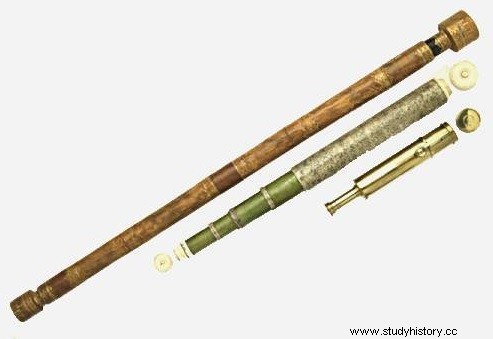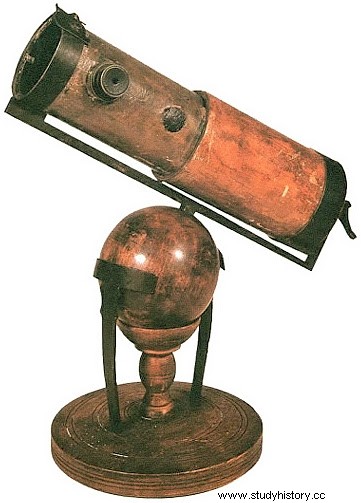 Most historians attribute the invention of the telescope to Hans Lip-pershey , a Dutch eyewear manufacturer. In 1608 , it combines a convex lens and a concave lens to create the first spotting scope. The discovery of the telescope marks a fundamental step in the history of humanity. The celestial observations made possible by this instrument will indeed completely upset the conception of the Universe that scientists had until then. Yesterday at the center of the world, man will be nothing more than stardust among billions of galaxies.
Most historians attribute the invention of the telescope to Hans Lip-pershey , a Dutch eyewear manufacturer. In 1608 , it combines a convex lens and a concave lens to create the first spotting scope. The discovery of the telescope marks a fundamental step in the history of humanity. The celestial observations made possible by this instrument will indeed completely upset the conception of the Universe that scientists had until then. Yesterday at the center of the world, man will be nothing more than stardust among billions of galaxies.
The invention of the telescope
Since the dawn of humanity, we have been watching the sky and trying to understand it. At first we only had our eyes, but four centuries ago an instrument was born that revolutionized astronomy. This instrument was made up of lenses, pieces of glass or cut rock crystal whose properties had been known since Antiquity:to concentrate the rays and magnify a little what was behind.
On October 2, 1608, a Dutch optician, Hans Lippershey, filed a patent for a device to "see distant things as if they were near". To do this, he placed two lenses in a tube, one at each end. The production of these glasses took off:the device was sold in Paris in April 1609, in May in Milan, in August in Venice and Naples. If the instrument turned out to be indispensable to the military for obvious reasons (seeing the enemy coming), it obviously didn't take long for a smart guy to remember the old ideas and turn it to the sky.
Towards the discovery of the universe
 The following year, Galilee , the brilliant Italian inventor, was the first to point a self-made astronomical telescope at the heavens. His observations allow him to discover the satellites of Jupiter , the mountains of the Moon , the phases of Venus , the spots on the Sun and countless stars invisible to the naked eye. After resting it, he sweeps away the thesis of the immutability of the cosmos, formulated in antiquity by Aristotle . And, above all, it validates the Copernican theory , which means that the Earth revolves around the Sun, and not the other way around.
The following year, Galilee , the brilliant Italian inventor, was the first to point a self-made astronomical telescope at the heavens. His observations allow him to discover the satellites of Jupiter , the mountains of the Moon , the phases of Venus , the spots on the Sun and countless stars invisible to the naked eye. After resting it, he sweeps away the thesis of the immutability of the cosmos, formulated in antiquity by Aristotle . And, above all, it validates the Copernican theory , which means that the Earth revolves around the Sun, and not the other way around.
In parallel with his remarkable work in optics, the English physicist Isaac Newton produced a telescope in 1671 that revolutionized astronomical observation:the reflector telescope. It consists of a concave primary mirror (objective mirror), placed at the bottom of an open tube; the secondary mirror, inclined at 45°, is flat and reflects the light coming from the primary mirror towards the eyepiece lens. An inverted image is thus observed at the bottom of the eyepiece. After Newton, the German William Herschel (1738-1822) observed many clusters and nebulae, and studied the structure of the Milky Way, and the Irishman Lord Rosse (1800-1867) discovered the spiral shapes of certain objects.
From then on, modern astronomy, which in the 20th century would lead to the discovery of the big bang (the original explosion that created a universe in continuous expansion), took off thanks to the telescope.
To go further
- A History of Astronomy by Marie-Christine de La Souchère. Ellipses, 2006.
- The 1001 inventions that changed the world by Jack Challoner. Flammarion, 2010.
